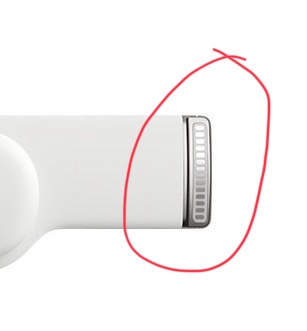Apple’s Vision Pro battery pack is hiding the final boss of Lightning cables::The Vision Pro’s battery connector is removable once you press the eject button, and it uses a 12-pin connector that looks like a wider version of a Lightning cable.
Im sure there’s a very legitimate reason why usbc wasn’t viable.
money?
That, the law not applying to this specific thing, and durability. The suits chose due to the former amd the engineers the latter.
The law does apply to “this specific thing”.
The law is essentially that (most) battery charge cables must use USB-C, and Apple’s headset does use a USB-C cable to charge the battery.
I believe that’s why they make it impossible to remove without a sim card tool, so they can argue that it’s an internal connection that the user is not supposed to remove.
Probably whenever the project got started they weren’t moving towards usb-c yet. Through the design iterations and redesigns it somehow stuck because it worked and no one at apple had a complaint.
no one at apple had a complaint
Of cour$e they didn’t. Don’t want anyone el$e to be able to $ell acce$$tries.
Could have been hard wired, but atleast this is replaceable.
yay, I’m glad I can buy a spare proprietary connector from Apple Inc™
If it was hardwired you would need to buy a whole new kit…
And does anyone even know the tech specs to know if an existing cable is capable of providing the power the device needs?
USB C cables can provide more than enough if made properly. No way this device exceeds those specs.
If it was hardwired you would need to buy a whole new kit…
Nah, Apple will gladly take your money for a replacement.
And I have no idea of the specs, but I’ve seen some truly power hungry laptops that charge with USB-C.
No… but you agree as well… what? A battery with an attached cable kit would cost vastly more than just a replaceable cable mate. Atleast Apple didn’t go that route, of course they want your money, they could have taken more by not having a replaceable cable at all……
The pack charges with USB-c this cable goes from headset to battery pack and could provide more power or even data than what usb-c does. So atleast it’s replaceable instead of being hardwired and needing to buy a whole new kit to replace a damaged connecto/cable.
Removed by mod
USB PD* can, not usb c. It uses the same connector, but it’s an entirely different standard, but you wouldn’t understand this if you just think I’m a troll…
Yes, it’s called being a realist and understanding how the world works, it’s the opposite of being brainwashed, like you are for hating Apple for no other reason than to hate. They suck, I never said otherwise, but it’s funny how pointing out what should be painfully obvious makes me the troll… right………
I think it’s reasonable.
First of all they didn’t want to put a battery on the headset. Fair enough, even without a battery it’s heavier than most headsets.
That decision means the cable doesn’t just need to provide average power consumption, it also needs to be able to handle peak power consumption. It seems reasonable that the headset has similar peak power to a Mac Mini - which has a 185 Watt power supply.
USB can provide up to 240 Watts, however it needs relatively high voltage to do that over thin cables permitted in the USB specification. 48 Volts for 240 Watt power delivery and 20 Volts for 100 Watts.
Vision Pro is only 13 Volts - which means that cable almost certainly has thicker wires than a standard USB cable. If you tried to power a Vision Pro over a standards compliant thin USB wires it would likely be a fire risk at only 13 Volts.
Apple could solve that by using 48 Volts… but then they’d have to convert 48V down to 13V… and they need to do it with very light weight and small components. Those conversions are not free, especially with DC power. It might even be that the conversion is so inefficient that you need more than 240 Watts to power the headset.
But even if 240 W is enough (it probably is), it would also reduce battery life. And battery life is already an area where the headset isn’t really good enough. So, in summary, yeah I do think it’s reasonable to use a proprietary power cable. This headset is just too close to the technical capabilities of a USB cable.
Worse… a lot of USB cables aren’t even compliant with the specification. You could burn someone’s house down if the cable is non-compliant.
There’s nothing reasonable about these assumptions.
There’s no way the VisionPro gets even close to 100W. Why? Because heat dissipation. The vast majority of power drawn by semiconductors is dissipated as heat and, in a device that’s strapped to someone’s face, there’s simply no way to dissipate hundreds of watts.
Also, knowing the battery pack size and battery life, it’s easy to guesstimate the power consumption.
“The Apple Vision Pro provides approximately 2 hours of battery life. Based on its size, the internal battery capacity is estimated to be within 20,000mAh (74Wh), resulting in an overall power consumption of around 30W.”
Even if we assume the double of that 30W, it’s well within USB-C standards.
Very good explanation. If usb-c is good enough for a MacBook, it’s definitely good enough for a small headset - no excuses!
I think you’re confusing volts and amps. Higher amperage wire has thicker copper conductors. Higher voltage wire has better insulation and some standards about how far connections have to sit. Raising voltage increases the chance of sparks, but amperage is what runs into heat problems with modern insulation. Wattage (power) is simply Volts x Amps. To get higher wattage, you can increase volts or amps (or both of course), depending on what materials and devices you have available. The whole point of going to higher voltages in usb is to carry more power without making the cables thicker and without overheating thin wires.
Most circuit boards are 5v. I’m sure Apple already has a converter on board. Also, the DC conversion problem is outdated - both on difficulty and inefficiency. Solid state devices are able to switch power on and off at a frequency to make an onboard converter coil work with the same efficiency as AC. The little extra heat lost from the switchers is made up for by not wasting time/energy on phase cycling. Check out “buck buck” converters.
Volts, amps, and watts are all different units and do not interchange. They are related, but serve different functions.
Fun fact: powerlines all use much higher voltages on the transmission wires than what you have in your house. The lower amperage (but same wattage) uses less material for wiring and loses less energy as heat along the way. North American houses have 120v, the transformers on the nearest telephone poles drop it from 440v, and the overhead lines are 440,000v with various possibilities in between substations
Congratulations
For what?
On buying their bs
That’s… not how it works.
That makes sense.
Thank you for the explanation
Honestly I appreciate Apple engineers’ sense of humor here
Lol, if apple discontinues vision pro and your battery swells, you only have eWaste left
You likely have waste regardless
Typical Apple move.
Now, that’s petty as fuck Mind you, they’re part of the consortium that made USB-C a thing…
It’s probably called a LIGHTNING cable.
This is the best summary I could come up with:
Ray Wong of Inverse discovered a hidden joy today: The Apple Vision Pro power cable connects to the battery with what may well be Lightning’s final form.
Using a SIM removal tool, he pushed into a small hole in the silver external battery pack of the Vision Pro next to the cable, and…
Out it popped, revealing what looks like a bigger, 12-pin version of the connector Apple’s iPhone moved away from last year.
Nilay Patel, Verge editor-in-chief and Vision Pro reviewer, gave it a shot, and what do you know?
Like a Palpatinian twist, somehow, Lightning returned, with all the hallmarks of Apple’s outgoing connector, just wider and with more pins.
Whether this was Apple intentionally propping up the crumbling walls of its garden or it’s just trolling everyone after the EU essentially forced it to switch the iPhone to USB-C, it’s a funny discovery:
The original article contains 228 words, the summary contains 146 words. Saved 36%. I’m a bot and I’m open source!
Like a Palpatinian twist, somehow, Lightning returned,
Lmao
And that’s the joke we went with? Not the quip that was tailor made for exactly this situation?
Everyone’s right, journalism is trash these days.
Eh true, but they’re attempting to write for a wider audience than just the jrpg enthusiasts.
Is it just for power, or does it double as some kind of data cable?
It has 24 pins. Power would be two or three pins.
24 is exactly the number you’d need to have a thunderbolt connection… which could be interesting, though I don’t think Apple has said anything about it being used for that.
Sorry friends. Here’s the Exalted form:



deleted by creator














